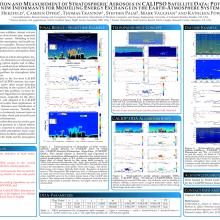Detection and Measurement of Stratospheric Aerosols in CALIPSO Satellite Data: Potential new Informants for Modeling Energy Exchange in the Earth-Atmosphere System
Ute
Herzfeld
University of Colorado Boulder
Poster
Tenuous aerosols resultant from wildfires, distant volcanic eruptions, Asian and Saharan dust storms play important roles in the Earth-Atmosphere system. Modeling of heat flux between the Earth and the atmosphere and health impacts of pollution are only two examples. Tenuous aerosols have been found to be transported around the entire Earth. Yet tenuous layers often go undetected in atmospheric lidar data.
The complexity of data situations in which atmospheric layers are recorded in lidar data,
by themselves or interspersed with cloud layers of varying optical depths and at different altitudes, and in addition resultant from different background situations of daytime, night and dusk, often exceeds the capabilities of classic algorithms for atmospheric lidar data analysis and classification.
Tenuous aerosols are recorded in the low-level CALIOP data from NASA's CloudSat/CALIPSO mission, but especially stratospheric aerosol layers often escape detection and classifcation partly or entirely in the current CALIOP data analysis scheme.
To solve this problem, we have developed the Density-Dimension Algorithm for atmospheric lidar data analysis (DDA-atmos), originally for the atmospheric data from ICESat-2, and adapted it to CALIOP data. In this talk, we present results from applications of the CALIOP-DDA-atmos to detection and classification of stratospheric aerosols from various sources. Notably, the DDA-atmos allows detection of extremely tenuous layers in presence of complex types of other cloud and aerosol layers across a large range of optical thicknesses.
The goal is to provide an algorithm that may be used to generate improved CALIOP data products in a future release. The resultant data product is expected to yield a data base that will include faint, subvisible atmospheric layers especially in the stratosphere and thus facilitate updated modeling of energy fluxes between the Earth and the atmosphere with reduced uncertainty.
The complexity of data situations in which atmospheric layers are recorded in lidar data,
by themselves or interspersed with cloud layers of varying optical depths and at different altitudes, and in addition resultant from different background situations of daytime, night and dusk, often exceeds the capabilities of classic algorithms for atmospheric lidar data analysis and classification.
Tenuous aerosols are recorded in the low-level CALIOP data from NASA's CloudSat/CALIPSO mission, but especially stratospheric aerosol layers often escape detection and classifcation partly or entirely in the current CALIOP data analysis scheme.
To solve this problem, we have developed the Density-Dimension Algorithm for atmospheric lidar data analysis (DDA-atmos), originally for the atmospheric data from ICESat-2, and adapted it to CALIOP data. In this talk, we present results from applications of the CALIOP-DDA-atmos to detection and classification of stratospheric aerosols from various sources. Notably, the DDA-atmos allows detection of extremely tenuous layers in presence of complex types of other cloud and aerosol layers across a large range of optical thicknesses.
The goal is to provide an algorithm that may be used to generate improved CALIOP data products in a future release. The resultant data product is expected to yield a data base that will include faint, subvisible atmospheric layers especially in the stratosphere and thus facilitate updated modeling of energy fluxes between the Earth and the atmosphere with reduced uncertainty.

herzfeld-ute-poster.pdf
(1.53 MB)
Meeting homepage
